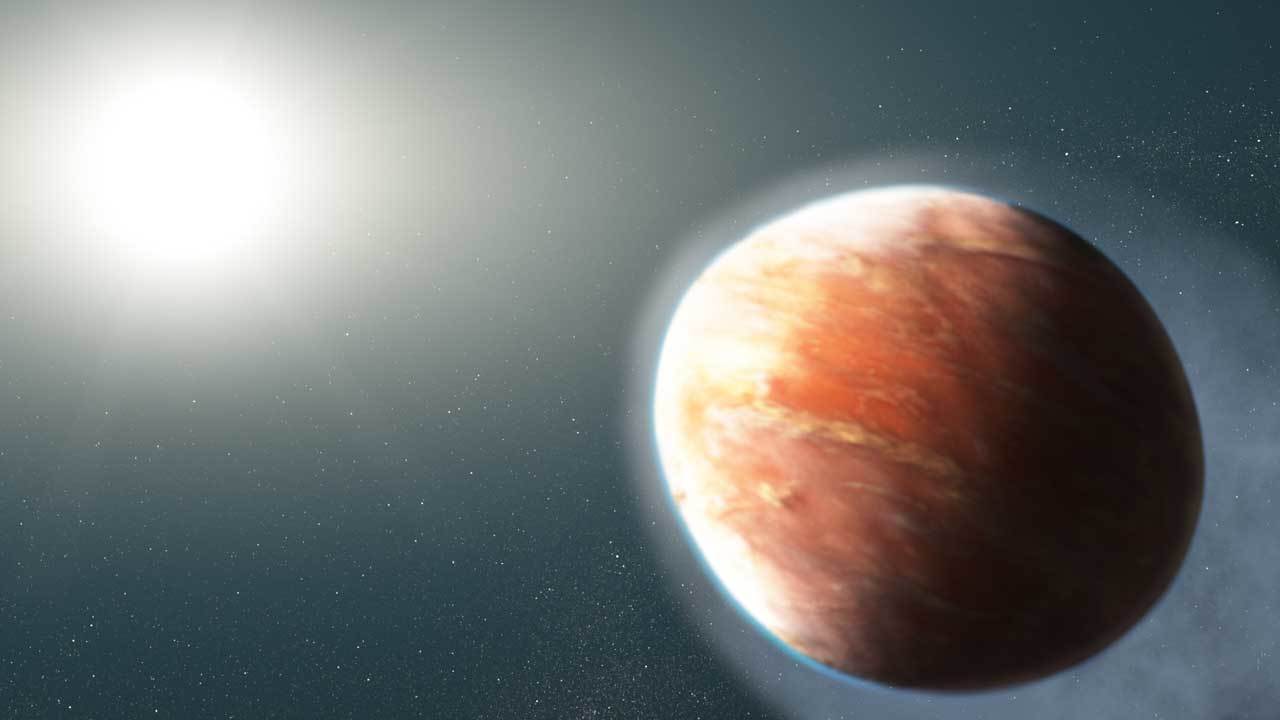The search for exoplanets has revealed types of planets that are nothing like the worlds in our own Solar System. One such type is the hot-Jupiter. They’re gas giants like Jupiter that orbit their host star very closely. That proximity raises their temperatures to extreme heights.
Hot-Jupiters can be hot enough to vaporize metals, making their atmospheres un-Earthlike. A team of astronomers examining one exoplanet has found 7 different gaseous metals in its atmosphere.
Astronomers discovered the hot-Jupiter Wasp-121b in 2015. It’s about 850 light-years away in the constellation Puppis. Its mass is about 1.18 times greater than Jupiter’s and its radius is about 1.81 times greater than Jupiter’s. The exoplanet is about 40 times closer to its star than Earth is to the Sun, and it orbits its star in only 1.27 days.
Astronomers have been studying the planet’s atmosphere since its discovery. Among other things, it was the first exoplanet found with water vapor in its stratosphere. The extremely high temperature of its upper atmosphere means that several metals are vaporized, too.
The paper presenting these findings is titled “Hot Exoplanet Atmospheres Resolved with Transit Spectroscopy (HEARTS) IV. A spectral inventory of atoms and molecules in the high-resolution transmission spectrum of WASP-121b.” The lead author is Jens Hoeijmakers, a postdoctoral research fellow at the National Centre of Competence in Research PlanetS at the Universities of Bern and Geneva. The new study is published in the journal Astronomy and Astrophysics.
“With the same techniques we use today, instead of just detecting signatures of gaseous iron or vanadium, we will be able to focus on biosignatures, signs of life such as the signatures of water, oxygen, and methane.”
Lead Author Jens Hoeijmakers, post-doctoral research fellow at the National Centre of Competence in Research PlanetS at the Universities of Bern and Geneva.
![The Puppis Constellation. By IAU and Sky & Telescope magazine (Roger Sinnott & Rick Fienberg) - [1], CC BY 3.0, https://commons.wikimedia.org/w/index.php?curid=15412181](https://www.universetoday.com/wp-content/uploads/2020/10/Puppis.png)
Wasp-121b can reach temperatures of between 2500 to 3000 degrees Celsius (4500 to 5400 F.) Because of those extreme temperatures, astronomers consider the exoplanet a prime candidate to study these ultra-hot planets. In the earlier days of exoplanet research, astronomers thought that these blistering hot worlds would have relatively simple atmospheres since the extreme heat prohibited the formation of many complex chemical compounds.
That changed when researchers discovered vanadium in 121b’s atmosphere.
“To my surprise, we actually found strong signatures of vanadium in the observations.”
LEAD AUTHOR JENS HOEIJMAKERS, POST-DOCTORAL RESEARCH FELLOW AT THE NATIONAL CENTRE OF COMPETENCE IN RESEARCH PLANETS AT THE UNIVERSITIES OF BERN AND GENEVA.
“The earlier studies showed that there is a lot going on in its atmosphere,” lead author Hoeijmakers said in a press release. Researchers attributed the planet’s atmospheric complexity to the presence of vanadium, but not everyone was convinced. “Previous studies tried to explain these complex observations with theories that did not seem plausible to me,” said Hoeijmakers. He thought that vanadium couldn’t be responsible, and the presence of another metal like titanium was necessary.

Hoeijmakers and his colleagues decided to look deeper. They examined data from HARPS, the High Accuracy Radial velocity Planet Searcher. HARPS is a spectrograph at the ESO’s La Silla Observatory in the Chilean Atacama Desert.
“But it turned out that they were right,” admits Hoeijmakers unequivocally, referring to previous researchers who pointed to vanadium. “To my surprise, we actually found strong signatures of vanadium in the observations.” But the surprise didn’t end with vanadium.
HARPS can examine its targets at a very high spectral resolution. The team used HARPS data, and they also reexamined and elaborated on existing Hubble Space Telescope observations of WASP-121b. They found that there are at least six other gaseous metals in 121b’s atmosphere alongside the vanadium: Iron, chromium, calcium, sodium, magnesium, and nickel.
“All metals evaporated as a result of the high temperatures prevailing on WASP-121b,” explains Hoeijmakers, “thus ensuring that the air on the exoplanet consists of evaporated metals, among other things.”
Astronomers have detected vaporized metals in exoplanet atmospheres before. The exoplanet WASP-76b was discovered in 2013, and atmospheric research revealed the presence of iron rain, among other things. It’s tidally locked to its star and the dayside is hot enough to vaporize iron, which then falls as rain after it condenses in the cooler nightside.

But WASP-121b is different. It’s not only its metallic atmosphere that’s unusual. The planet is so close to its star that it’s stretched into a football shape. The atmosphere is out of equilibrium, and some of the metal vapors that the researchers identified are being shed into space as it loses its atmosphere. It’s likely that the planet itself is being ripped apart.
In a separate press release from NASA, researcher David Sing of the Johns Hopkins University in Baltimore, Maryland, said “The heavy metals are escaping partly because the planet is so big and puffy that its gravity is relatively weak. This is a planet being actively stripped of its atmosphere.”
“The hot Jupiters are mostly made of hydrogen, and Hubble is very sensitive to hydrogen, so we know these planets can lose the gas relatively easily,” Sing said. “But in the case of WASP-121b, the hydrogen and helium gas is outflowing, almost like a river, and is dragging these metals with them. It’s a very efficient mechanism for mass loss.”

Astronomers have found thousands of exoplanets, and now we’re getting better and better at studying them. And the future promises even more exoplanet-studying capabilities with telescopes like the James Webb Space Telescope. We’re still waiting for it to launch, but other missions like the ESA’s CHEOPS (CHaracterizing ExOPlanet Satellite) are already busy gathering data.
“After years of cataloging what is out there, we are now no longer just taking measurements.”
LEAD AUTHOR JENS HOEIJMAKERS, POST-DOCTORAL RESEARCH FELLOW AT THE NATIONAL CENTRE OF COMPETENCE IN RESEARCH PLANETS AT THE UNIVERSITIES OF BERN AND GENEVA.
For lead author Hoeijmakers, these study results are significant not just for WASP-121b, but for the field of exoplanet research in general. “With the same techniques we use today, instead of just detecting signatures of gaseous iron or vanadium, we will be able to focus on biosignatures, signs of life such as the signatures of water, oxygen, and methane,” says Hoeijmakers.
“After years of cataloging what is out there, we are now no longer just taking measurements,” explains the researcher, “but we are really beginning to understand what the data from the instruments show us. How planets resemble and differ from each other. In the same way, perhaps, that Charles Darwin began to develop the theory of evolution after characterizing countless species of animals, we are beginning to understand more about how these exoplanets were formed and how they work.”

It was only 25 years ago that astronomers discovered the first exoplanet, 51 Pegasi b. Prior to that discovery, it was mostly up to science fiction to describe planets in other solar systems, while they waited for actual science to catch up. Sci-fi writers did an admirable job, but now science is catching up.
If Hoeijmakers’ comment about Darwin is accurate, then one day we may have a much more complete taxonomy of exoplanets. Rather than useful but vague terms like “hot-Jupiter,” which describes the basics but glosses over a lot of detail, we may have a much-better defined system of names and classifications.
See you in the future.
More:
- Press Release: Vaporised metal in the air of an exoplanet
- Press Release: WASP-121b: A ‘Heavy Metal’ Exoplanet Shaped Like a Football
- Research: Hot Exoplanet Atmospheres Resolved with Transit Spectroscopy (HEARTS) IV. A spectral inventory of atoms and molecules in the high-resolution transmission spectrum of WASP-121 b
- Research: The Hubble Space Telescope PanCET Program: Exospheric Mg ii and Fe ii in the Near-ultraviolet Transmission Spectrum of WASP-121b Using Jitter Decorrelation

